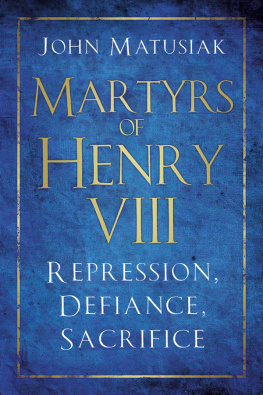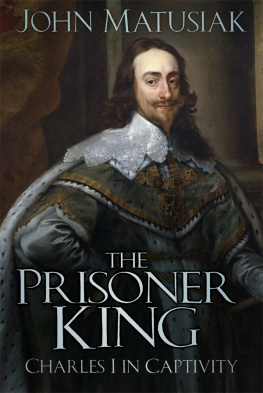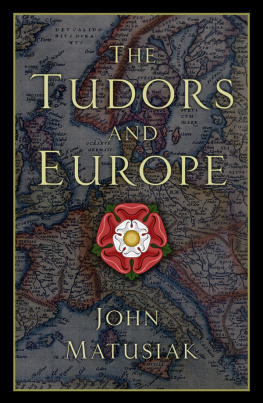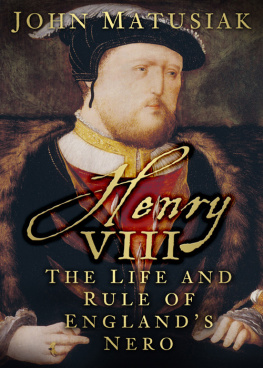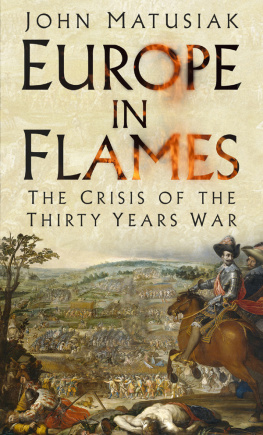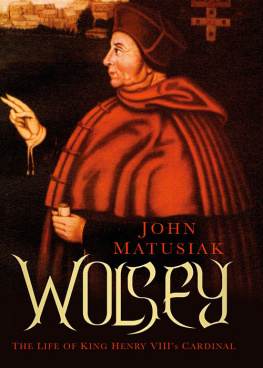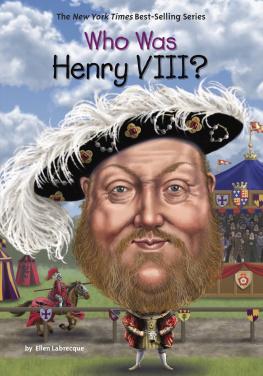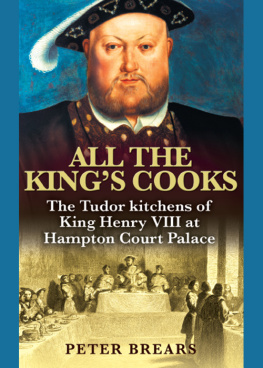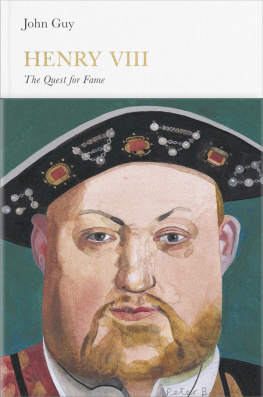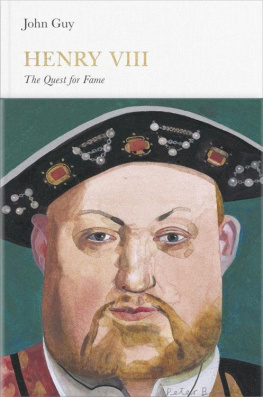John Matusiak - Martyrs of Henry VIII: Repression, Defiance, Sacrifice
Here you can read online John Matusiak - Martyrs of Henry VIII: Repression, Defiance, Sacrifice full text of the book (entire story) in english for free. Download pdf and epub, get meaning, cover and reviews about this ebook. year: 2019, publisher: The History Press, genre: Religion. Description of the work, (preface) as well as reviews are available. Best literature library LitArk.com created for fans of good reading and offers a wide selection of genres:
Romance novel
Science fiction
Adventure
Detective
Science
History
Home and family
Prose
Art
Politics
Computer
Non-fiction
Religion
Business
Children
Humor
Choose a favorite category and find really read worthwhile books. Enjoy immersion in the world of imagination, feel the emotions of the characters or learn something new for yourself, make an fascinating discovery.
- Book:Martyrs of Henry VIII: Repression, Defiance, Sacrifice
- Author:
- Publisher:The History Press
- Genre:
- Year:2019
- Rating:4 / 5
- Favourites:Add to favourites
- Your mark:
- 80
- 1
- 2
- 3
- 4
- 5
Martyrs of Henry VIII: Repression, Defiance, Sacrifice: summary, description and annotation
We offer to read an annotation, description, summary or preface (depends on what the author of the book "Martyrs of Henry VIII: Repression, Defiance, Sacrifice" wrote himself). If you haven't found the necessary information about the book — write in the comments, we will try to find it.
Martyrs of Henry VIII: Repression, Defiance, Sacrifice — read online for free the complete book (whole text) full work
Below is the text of the book, divided by pages. System saving the place of the last page read, allows you to conveniently read the book "Martyrs of Henry VIII: Repression, Defiance, Sacrifice" online for free, without having to search again every time where you left off. Put a bookmark, and you can go to the page where you finished reading at any time.
Font size:
Interval:
Bookmark:


Indignatio principis mors est.
(The wrath of the prince is death.)
Proverbs, 16:14
First published 2019
The History Press
97 St Georges Place, Cheltenham,
Gloucestershire, GL50 3QB
www.thehistorypress.co.uk
John Matusiak, 2019
The right of John Matusiak to be identified as the Author of this work has been asserted in accordance with the Copyright, Designs and Patents Act 1988.
All rights reserved. No part of this book may be reprinted or reproduced or utilised in any form or by any electronic, mechanical or other means, now known or hereafter invented, including photocopying and recording, or in any information storage or retrieval system, without the permission in writing from the Publishers.
British Library Cataloguing in Publication Data.
A catalogue record for this book is available from the British Library.
ISBN 978 0 7509 9354 8
Typesetting and origination by The History Press
Printed and bound in Great Britain by TJ International Ltd
eBook converted by Geethik Technologies
This day, the Nun of Kent, with two Friars Observant, two monks and one secular priest, were drawn from the Tower to Tyburn, and there hanged and headed. God, if it be his pleasure, have mercy on their souls.
John Hussee to Lord Lisle, Lisle Papers, v, 95.
In the early morning of Monday, 20 April 1534, as the sun ascended balefully upon her appointed day of destiny, a 28-year-old Benedictine nun by the name of Elizabeth Barton was awoken from her no-doubt meagre slumbers in the Tower of London, along with two Benedictine monks, two Franciscan friars and a former secretary to the Archbishop of Canterbury, to face her ultimate ordeal as an enemy of the Tudor state. Since no one in England had hitherto been executed in clerical garb, or would be until the following year, she was dressed on departure, we may safely assume, in a plain shift typical of the kind worn by condemned women, while her male counterparts, likewise convicted of high treason, wore cast-off gowns donated by the charitable. Bound on their backs, without ceremony or sympathy, to four wooden hurdles, their ankles securely lashed together and their hands tied in the attitude of prayer, the condemned were watched over by members of King Henry VIIIs Privy Council and in particular the Lieutenant of the Tower, Sir Edmund Walsingham, who had assumed responsibility for their handover after his superior, Sir William Kingston, the Towers Constable, had been taken ill. It was a heavy responsibility: weightier, certainly, than any the deputy lieutenant is likely to have envisaged when in 1520 he first succeeded Sir Richard Cholmondley in his current post at an annual salary of 100. For, like others that day, he too was henceforth tightly harnessed, though not to an executioners hurdle, but to a revolution that would lead he knew not where: one of unprecedented scale and significance, and one that would lead him before long to supervise a long line of illustrious prisoners, including Anne Boleyn, Catherine Howard, the Countess of Salisbury, the Marquess of Exeter, Lord Henry Montagu, the Duchess of Norfolk, and arguably the most famous, if not the most significant, of all the kings martyrs, Sir Thomas More, Englands one-time chancellor.
It was to Walsingham, indeed, that More is said to have delivered his final ironic quip upon ascending the scaffold the following year: I pray you, Master Lieutenant, see me safe up, and for my coming down, let me shift for myself. By that time, the full import of the governments intentions was clear: nothing less than the enactment of a seismic breach with the ancient Church of Rome and the systematic suppression of all those resolved to take that Churchs part. Neither statesman nor theologian and certainly no freethinker, Walsingham, in keeping with the vast majority of others caught up in the tumultuous events of these years, would dutifully follow his governments lead, trusting its judgements and executing its wishes out of an unquestioning mix of inbred loyalty and solid self-interest. Nor, of course, was it ever remotely likely to have been otherwise. He was, after all, a long-standing servant of the Crown, knighted by Thomas Howard four days after the Battle of Flodden more than twenty years earlier, and appointed a sewer in the royal household in 1521. Then, with an eagle eye for the main chance and by a judicious combination of earnest enterprise and the sixteenth-century equivalent of modern-day political correctness, he had become both a freeman of the Mercers Company, and, much more significantly still, a dutiful member of the packed jury that had tried and convicted Edward Stafford, 3rd Duke of Buckingham, a decade earlier. For such an upstanding member of Englands elites, the royal will was sacrosanct, its dictates irresistible, its retribution ineluctable.
Yet, for an intractable few, such ready compliance was never so straightforward an option, and the humble nun now laid supine before the Towers lieutenant in one of its many inter-connected courtyards was not only the first of that line chronologically, but at one point, arguably, a figure of no less potential significance than the altogether more exalted victims that succeeded her: a clear and present existential threat to the kings marital designs and the trigger for much that followed. Such was Elizabeth Bartons celebrity, in fact, that, according to one likely eyewitness, the Protestant cloth merchant Richard Hilles, she was now afforded pride of place and the dubious distinction of a hurdle to herself, as Walsingham duly entrusted her sorry body, and those of her associates, to the capitals two High Sheriffs, Thomas Kitson and William Forman, in return for the written receipt invariably engendered by the niceties of Tudor bureaucracy. Whereupon, the waiting horses were harnessed to their wretched human cargo, and the heavy escort of soldiers in attendance duly shouldered pikes in readiness for a clattering departure over the fortresss cobbled pathways. Passing by turns through the successive portcullises of the Bloody Tower and over the groaning drawbridge releasing them to the outside world, troops and officials alike were from this point onwards self-conscious participants in a carefully stage-managed public spectacle playing an indispensable supporting role to the helpless victims themselves, bound feet-first behind the horses as they bumped and jarred like cumbersome harrows over the uneven ground and unmade roads stretching far ahead of them through the heart of London and on to Tyburn Crossroads.
For the organisers, in particular, it was an occasion of much personal significance. High Sheriff Kitson, on the one hand, had come to London from Lancashire in his youth as an apprentice to the London mercer Richard Glasyer, but risen steadily to become Warden of the Mercers Company in 1533, by which time only ten other English merchants could compete with his cloth-dealing activities in Antwerp, Middleburg, and elsewhere in Flanders. Nor would the smooth running of the day ahead be any less crucial to his further prospects. Already the owner of the Duke of Buckinghams former manors of Hengrave in Suffolk and Colston Basset in Nottinghamshire, he was indeed to be knighted within the month, which made the faultless prosecution of his current task all the more pressing, since it was he, along with his counterpart William Forman, an alderman from the Cripplegate Ward in the City of London, who now assumed primary responsibility for the safe delivery of the condemned prisoners to Tyburn and the attentions of a certain Mr Cratwell, the capitals newly appointed executioner who, as a man of considerable consequence in Tudor society in his own right, was likewise keenly primed that morning. For this was his debut, and along with his assistants who numbered the men in charge of the brazier for burning the victims entrails and the cauldron for parboiling their quartered remains he too had much to prove, sedulously calculating the precise degree of torment entailed by the law and directing the various other underlings tending the Tyburn gallows, which consisted of two dark oaken uprights, high enough to ensure an unimpeded view for spectators, and a stout crossbeam, from which hung several well-oiled and flexible ropes. A conninge butcher in quartering of men, the executioner would himself be hanged for theft before a crowd of 20,000 baying spectators at Smithfield only four years later. But for now at least, on this spring day, he was lord of his calling, caught up in the most significant political execution of its kind for more than a decade, and surrounded by a busy throng of willing apprentices anxious to learn his craft.
Font size:
Interval:
Bookmark:
Similar books «Martyrs of Henry VIII: Repression, Defiance, Sacrifice»
Look at similar books to Martyrs of Henry VIII: Repression, Defiance, Sacrifice. We have selected literature similar in name and meaning in the hope of providing readers with more options to find new, interesting, not yet read works.
Discussion, reviews of the book Martyrs of Henry VIII: Repression, Defiance, Sacrifice and just readers' own opinions. Leave your comments, write what you think about the work, its meaning or the main characters. Specify what exactly you liked and what you didn't like, and why you think so.

